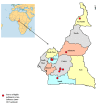Epidemiological Features of Highly Pathogenic Avian Influenza in Cameroon
- PMID: 30834103
- PMCID: PMC6369508
- DOI: 10.1155/2019/3796369
Epidemiological Features of Highly Pathogenic Avian Influenza in Cameroon
Abstract
The epidemiology of avian influenza is unknown in Cameroon despite the two outbreaks that occurred in 2006 and 2016-2017, respectively. In order to fill the gap, an attempt was made to provide some basic information on the epidemiology of highly pathogenic avian influenza in Cameroon. Thus, data were collected from follow-up reports of the second HPAI outbreaks prepared by the veterinary health officials of Cameroon and sent to the World Organisation for Animal Health (OIE). Two HPAI virus strains (H5N1 and H5N8) turned out to occur, with H5N1 virus involved in the Center, South, West, and Adamawa regions outbreaks and H5N8 involved in the Far North outbreak only. The affected hosts were the laying hens, backyard chickens, turkeys, guinea fowls, ducks, broiler and layer breeders, and geese for the H5N1 virus and the Indian peafowl (Pavo cristatus), pigeon, ducks, backyard chickens, and guinea fowls for the H5N8 virus. The first outbreak took place in Mvog-Betsi poultry complex in the Center region on the 20th May 2016 and spread to other regions. The mortality rate varied from 8% to 72% for H5N1 virus and was 96.26% for the H5N8 strain in Indian peafowl. No human case was recorded. The potential supporting factors for disease dissemination identified on the field were the following: poultry and eggs dealers moving from one farm, market, or town to another without any preventive care; poor biosecurity measures on farms and live poultry markets. After the first HPAI H5N1 virus outbreak in 2006, the second HPAI outbreak ten years later (2016-2017) involving two virus strains is a cause of concern for the poultry industry. The Cameroon Epidemio-Surveillance Network needs to be more watchful.
Figures


Similar articles
-
Highly pathogenic avian influenza A/H5N1 Clade 2.3.2.1c virus in poultry in Cameroon, 2016-2017.Avian Pathol. 2018 Dec;47(6):559-575. doi: 10.1080/03079457.2018.1492087. Epub 2018 Oct 2. Avian Pathol. 2018. PMID: 29985640
-
Highly Pathogenic and Low Pathogenic Avian Influenza H5 Subtype Viruses in Wild Birds in Ukraine.Avian Dis. 2019 Mar 1;63(sp1):235-245. doi: 10.1637/11880-042718.1. Avian Dis. 2019. PMID: 31713401
-
Highly Pathogenic and Low Pathogenic Avian Influenza H5 Subtype Viruses in Wild Birds in Ukraine.Avian Dis. 2019 Mar 1;63(sp1):219-229. doi: 10.1637/11879-042718-ResNote.1. Avian Dis. 2019. PMID: 31131580
-
Multiple Introductions of Reassorted Highly Pathogenic Avian Influenza H5Nx Viruses Clade 2.3.4.4b Causing Outbreaks in Wild Birds and Poultry in The Netherlands, 2020-2021.Microbiol Spectr. 2022 Apr 27;10(2):e0249921. doi: 10.1128/spectrum.02499-21. Epub 2022 Mar 14. Microbiol Spectr. 2022. PMID: 35286149 Free PMC article.
-
Public health concerns of highly pathogenic avian influenza H5N1 endemicity in Africa.Vet World. 2017 Oct;10(10):1194-1204. doi: 10.14202/vetworld.2017.1194-1204. Epub 2017 Oct 8. Vet World. 2017. PMID: 29184365 Free PMC article. Review.
Cited by
-
Impact of Biosecurity on Production Performance and Antimicrobial Usage in Broiler Farms in Cameroon.Animals (Basel). 2025 Jun 16;15(12):1771. doi: 10.3390/ani15121771. Animals (Basel). 2025. PMID: 40564323 Free PMC article.
-
Avian Influenza Viruses Detected in Birds in Sub-Saharan Africa: A Systematic Review.Viruses. 2020 Sep 7;12(9):993. doi: 10.3390/v12090993. Viruses. 2020. PMID: 32906666 Free PMC article.
-
Microbial Contamination of Chicken Litter Manure and Antimicrobial Resistance Threat in an Urban Area Setting in Cameroon.Antibiotics (Basel). 2020 Dec 29;10(1):20. doi: 10.3390/antibiotics10010020. Antibiotics (Basel). 2020. PMID: 33383622 Free PMC article.
-
Prioritizing smallholder animal health needs in East Africa, West Africa, and South Asia using three approaches: Literature review, expert workshops, and practitioner surveys.Prev Vet Med. 2021 Apr;189:105279. doi: 10.1016/j.prevetmed.2021.105279. Epub 2021 Jan 27. Prev Vet Med. 2021. PMID: 33581421 Free PMC article.
-
Investigation of influenza A of pandemic potential and MERS-Coronavirus in humans in Cameroon.BMC Res Notes. 2025 Mar 31;18(1):133. doi: 10.1186/s13104-025-07179-2. BMC Res Notes. 2025. PMID: 40165265 Free PMC article.
References
-
- FAO. Highly pathogenic H5 avian influenza in 2016 and 2017 – observations and future perspectives. Focus on, no. 11, 2017.
-
- OIE (World Organisation for Animal Health) OIE Situation Report for Avian Influenza. 2017, http://www.oie.int/fileadmin/Home/eng/Animal_Health_in_the_World/docs/pd....
LinkOut - more resources
Full Text Sources
Miscellaneous

